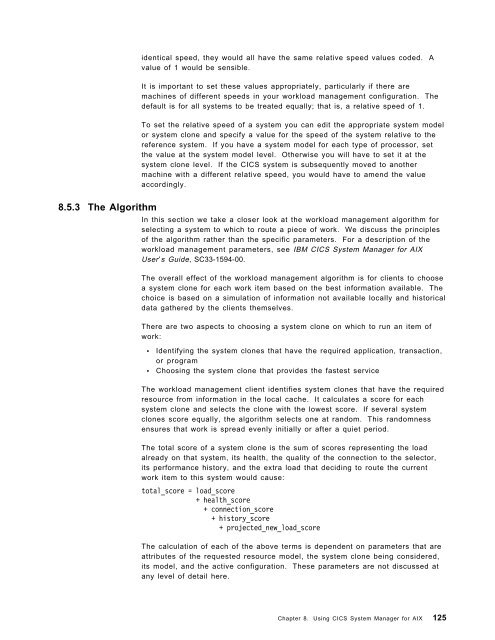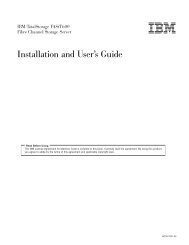Addressing OLTP Solutions with CICS: The Transaction Server ... - Ibm
Addressing OLTP Solutions with CICS: The Transaction Server ... - Ibm
Addressing OLTP Solutions with CICS: The Transaction Server ... - Ibm
You also want an ePaper? Increase the reach of your titles
YUMPU automatically turns print PDFs into web optimized ePapers that Google loves.
8.5.3 <strong>The</strong> Algorithm<br />
identical speed, they would all have the same relative speed values coded. A<br />
value of 1 would be sensible.<br />
It is important to set these values appropriately, particularly if there are<br />
machines of different speeds in your workload management configuration. <strong>The</strong><br />
default is for all systems to be treated equally; that is, a relative speed of 1.<br />
To set the relative speed of a system you can edit the appropriate system model<br />
or system clone and specify a value for the speed of the system relative to the<br />
reference system. If you have a system model for each type of processor, set<br />
the value at the system model level. Otherwise you will have to set it at the<br />
system clone level. If the <strong>CICS</strong> system is subsequently moved to another<br />
machine <strong>with</strong> a different relative speed, you would have to amend the value<br />
accordingly.<br />
In this section we take a closer look at the workload management algorithm for<br />
selecting a system to which to route a piece of work. We discuss the principles<br />
of the algorithm rather than the specific parameters. For a description of the<br />
workload management parameters, see IBM <strong>CICS</strong> System Manager for AIX<br />
User′s Guide, SC33-1594-00.<br />
<strong>The</strong> overall effect of the workload management algorithm is for clients to choose<br />
a system clone for each work item based on the best information available. <strong>The</strong><br />
choice is based on a simulation of information not available locally and historical<br />
data gathered by the clients themselves.<br />
<strong>The</strong>re are two aspects to choosing a system clone on which to run an item of<br />
work:<br />
• Identifying the system clones that have the required application, transaction,<br />
or program<br />
• Choosing the system clone that provides the fastest service<br />
<strong>The</strong> workload management client identifies system clones that have the required<br />
resource from information in the local cache. It calculates a score for each<br />
system clone and selects the clone <strong>with</strong> the lowest score. If several system<br />
clones score equally, the algorithm selects one at random. This randomness<br />
ensures that work is spread evenly initially or after a quiet period.<br />
<strong>The</strong> total score of a system clone is the sum of scores representing the load<br />
already on that system, its health, the quality of the connection to the selector,<br />
its performance history, and the extra load that deciding to route the current<br />
work item to this system would cause:<br />
total_score = load_score<br />
+ health_score<br />
+ connection_score<br />
+ history_score<br />
+ projected_new_load_score<br />
<strong>The</strong> calculation of each of the above terms is dependent on parameters that are<br />
attributes of the requested resource model, the system clone being considered,<br />
its model, and the active configuration. <strong>The</strong>se parameters are not discussed at<br />
any level of detail here.<br />
Chapter 8. Using <strong>CICS</strong> System Manager for AIX 125
















